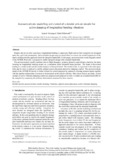JavaScript is disabled for your browser. Some features of this site may not work without it.
| dc.contributor.author | Verhaegen, Anatole | |
| dc.contributor.author | Zbikowski, Rafal | |
| dc.date.accessioned | 2017-04-06T13:56:08Z | |
| dc.date.available | 2017-04-06T13:56:08Z | |
| dc.date.issued | 2017-03-07 | |
| dc.identifier.citation | Anatole Verhaegen, Rafał Żbikowski, Aeroservoelastic modelling and control of a slender anti-air missile for active damping of longitudinal bending vibrations, Aerospace Science and Technology, Volume 66, July 2017, Pages 20-27 | en_UK |
| dc.identifier.issn | 1270-9638 | |
| dc.identifier.uri | http://dx.doi.org/10.1016/j.ast.2017.03.001 | |
| dc.identifier.uri | https://dspace.lib.cranfield.ac.uk/handle/1826/11745 | |
| dc.description.abstract | Slender anti-air missiles experience longitudinal bending in supersonic flight and yet their autopilots are designed under the rigid-body assumption. Such autopilot design employs notch filters to remove the modal frequencies of the elastic airframe but this approach limits the autopilot bandwidth. In this paper, aeroservoelastic modelling and control of the ASTER 30 missile is proposed to enable autopilot design with extended bandwidth. The aeroservoelastic model combines missile flight dynamics, actuator dynamics and airframe elasticity, the latter focusing on longitudinal bending treated as a continuous Euler–Bernoulli beam problem. The beam is discretised leading to a nodal model and the modal analysis is then performed. The modal model is expressed in the state-space form and its order is reduced to enable optimal sensor placement and active damping control. The aeroservoelastic model of the ASTER 30 missile is further refined for control purposes by optimally choosing actuator inputs together with the number and position of sensors to be mounted on the missile airframe. Once these choices are made, several variants of active vibration damping control are proposed and analysed in order to enable an extended bandwidth for the autopilot by countering the airframe deformation measured by these sensors. | en_UK |
| dc.language.iso | en | en_UK |
| dc.publisher | Elsevier | en_UK |
| dc.rights | Attribution-NonCommercial-NoDerivatives 4.0 International | |
| dc.rights.uri | http://creativecommons.org/licenses/by-nc-nd/4.0/ | |
| dc.subject | Flexible missile | en_UK |
| dc.subject | Aeroservoelastic model | en_UK |
| dc.subject | Bending vibrations | en_UK |
| dc.subject | Optimal sensor placement | en_UK |
| dc.subject | Active vibration damping | en_UK |
| dc.title | Aeroservoelastic modelling and control of a slender anti-air missile for active damping of longitudinal bending vibrations | en_UK |
| dc.type | Article | en_UK |
Files in this item
This item appears in the following Collection(s)
-
Staff publications (SATM) [4368]

